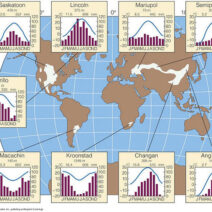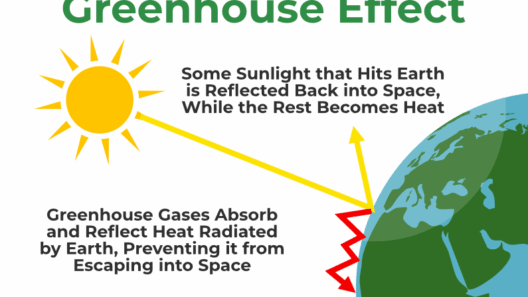Exploring the Impact of the Greenhouse Effect on Earth’s Temperature
The phenomenon known as the greenhouse effect is a fundamental aspect of Earth’s climate system. It arises when certain gases in the atmosphere trap heat emanating from the surface, thereby maintaining the planet’s average temperature. While this natural process is essential for sustaining life, the intensification of the greenhouse effect due to human activities has raised profound concerns about global warming and climate change. Understanding this delicate balance is crucial as we navigate the intricate interplay between atmospheric composition and temperature fluctuations.
The Mechanics of the Greenhouse Effect
At its core, the greenhouse effect relies on the presence of greenhouse gases, including carbon dioxide (CO2), methane (CH4), and nitrous oxide (N2O). These gases absorb and emit infrared radiation, effectively insulating the Earth. Solar radiation enters the atmosphere, warming the Earth’s surface. Some of this energy is then radiated back into space as heat. However, greenhouse gases prevent a significant portion of this heat from escaping, thereby increasing the planet’s temperature.
The process is akin to a thermal blanket – it helps maintain a habitable climate, yet excessive concentrations of these gases can lead to overheating. The dramatic rise in CO2 levels, primarily from fossil fuel combustion, deforestation, and industrial practices, has been a significant driver of the current climate crisis. Consequently, understanding how these gases accumulate and influence temperature is imperative for addressing the urgent challenges facing our environment.
Consequences of Elevated Temperatures
The implications of an escalating greenhouse effect are manifold. One of the most noticeable consequences is the increase in average global temperatures, which has far-reaching effects on natural systems and human activities alike.
Altered Weather Patterns
As temperatures rise, the frequency and intensity of extreme weather events have become more pronounced. Heatwaves, storms, and heavy precipitation, which were previously deemed sporadic, have now become common. The interrelationship between temperature and atmospheric dynamics is complex. As warm air holds more moisture, the potential for intense rainfall events increases, leading to flooding in some regions while triggering drought conditions in others. Understanding these shifting weather patterns is vital for communities as they adjust to the new climate realities.
Changing Ecosystems
Higher temperatures also instigate significant shifts in ecosystems. Various species are sensitive to temperature changes and may be forced to migrate to cooler habitats or face extinction. For example, coral reefs, often referred to as the “canaries of the sea,” are highly susceptible to temperature increases. Warming waters can lead to coral bleaching, where symbiotic algae are expelled, ultimately resulting in the death of these essential marine populations. Such biological upheavals not only disrupt ecological balance but also threaten human livelihoods that depend on these ecosystems.
The Role of Oceans
The oceans act as both a buffer and a thermostat in the context of climate change. They absorb a considerable amount of the excess heat generated by greenhouse gases. However, this comes at a cost. Ocean warming contributes to sea-level rise through thermal expansion and melting ice caps. Increased sea levels pose severe threats to coastal communities, leading to more frequent flooding and erosion. Furthermore, the absorption of CO2 by oceans leads to acidification, endangering marine life and disrupting fishing industries globally.
Mitigation Strategies for a Changing World
Addressing the impacts of the greenhouse effect requires a multi-faceted approach. Transitioning to renewable energy sources, enhancing energy efficiency, and adopting sustainable agricultural practices are critical steps toward mitigating climate change.
Renewable Energy Revolution
The shift from fossil fuels to renewable energy sources, such as solar, wind, and hydroelectric power, is paramount. These alternatives not only reduce greenhouse gas emissions but also create sustainable economic opportunities. Effective policies encouraging investment in these technologies can facilitate the transition toward a greener economy.
Enhancement of Carbon Sinks
Preservation and restoration of natural ecosystems, including forests and wetlands, play a crucial role in combating climate change. These ecosystems act as carbon sinks, absorbing CO2 from the atmosphere. Moreover, reforestation initiatives and sustainable land management practices can foster resilience against climate variability.
The Importance of Global Cooperation
No nation can combat climate change in isolation. International collaboration is vital, as greenhouse gas emissions are a global concern. Agreements like the Paris Accord aim to unite countries in efforts to limit global warming to well below 2 degrees Celsius. Promoting shared technologies, financial assistance, and capacity-building can catalyze a collective response.
Conclusion: The Path Forward
The greenhouse effect is a natural and essential phenomenon, yet its amplification through human activities necessitates immediate action. The rise in Earth’s temperatures poses significant challenges that extend far beyond environmental degradation; it affects social equity, global security, and economic stability. By comprehending the mechanisms at play and implementing targeted mitigation strategies, society can work collectively toward a more sustainable future. The pursuit for equilibrium requires commitment and innovation, as well as an unwavering dedication to preserving the delicate balance of our planet’s climate.








